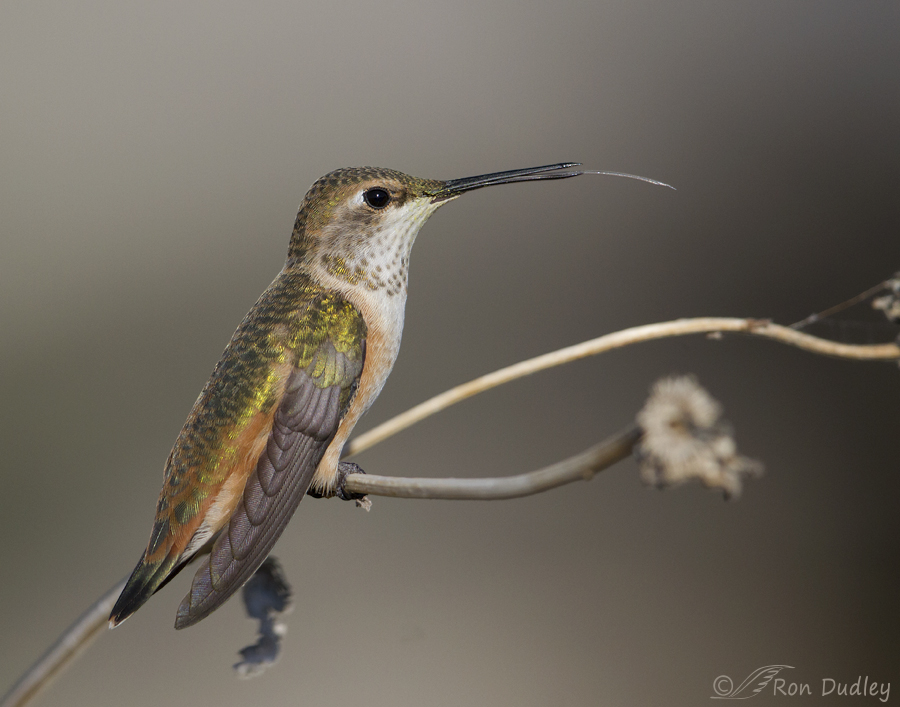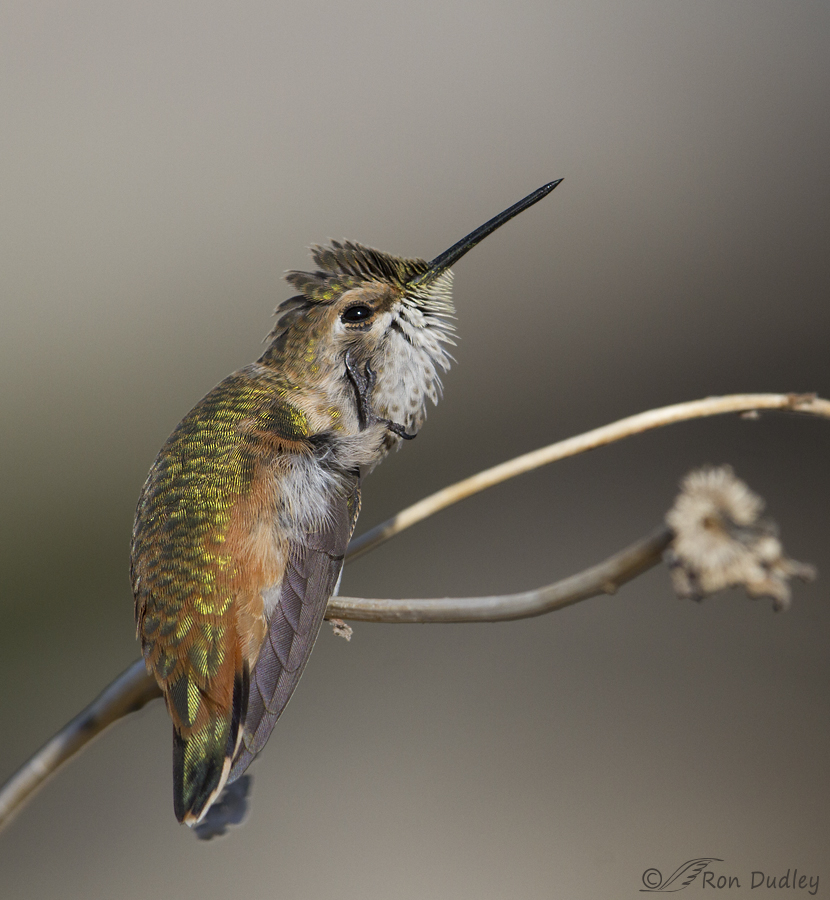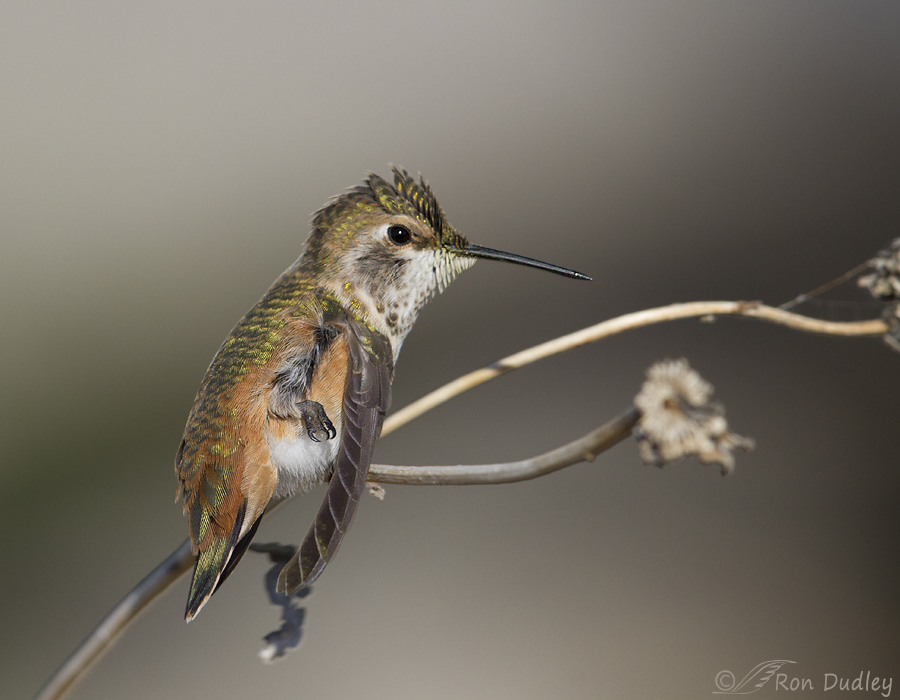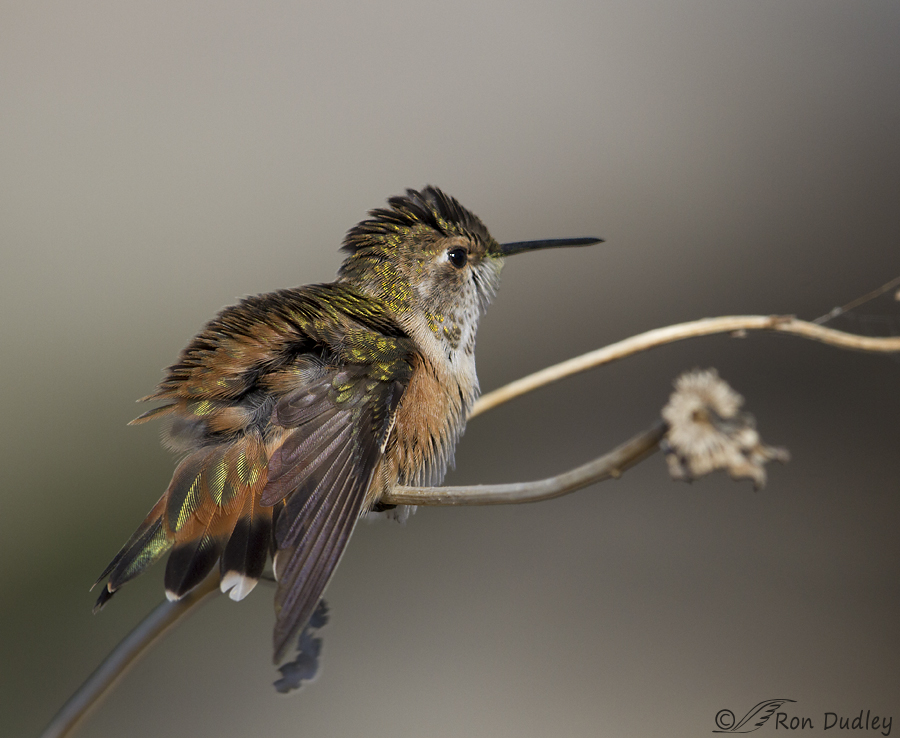Yesterday morning I spent more time with the hummingbirds on Antelope Island. This female Rufous Hummingbird (it may be an immature male but for the sake of convenience I’ll refer to the bird as “she”) perched close and gave me some interesting poses. I’m not fond of the old sunflower stem perch because it’s out of focus, parts of it are too bright and there’s an annoying dead leaf hanging down below the hummer but I like the poses and behaviors.

1/ 2500, f/6.3, ISO 500, Canon 7D, Canon EF500mm f/4L IS II USM +1.4 tc, natural light, not baited, set up or called in
Within a few moments of settling on the perch she stuck out her long tongue and at the same time demonstrated rhynchokinesis, the ability of some birds (cranes, shorebirds, swifts and hummingbirds) to flex their bills out of their normal shape. Here you see that the tips have momentarily separated.

1/ 1600, f/8, ISO 500, Canon 7D, Canon EF500mm f/4L IS II USM +1.4 tc, natural light, not baited, set up or called in
Then she had an itch under her eye and it must have been a doozy because she scratched it repeatedly. Though it may look like her foot is coming from beneath her wing that’s not the case. She dropped her wing and brought her leg and foot over the top of the wing-base (shoulder) to reach the itch.

1/ 1600, f/8, ISO 500, Canon 7D, Canon EF500mm f/4L IS II USM +1.4 tc, natural light, not baited, set up or called in
In an earlier shot you can see how she dropped her wing before bringing her foot and leg over the top. The attachment of the upper leg to the body in birds is often higher up than I expect it to be.

1/ 1600, f/8, ISO 500, Canon 7D, Canon EF500mm f/4L IS II USM +1.4 tc, natural light, not baited, set up or called in
After scratching she fluffed (roused). Though I wish she had looked back at me while she did it I love the play of light on the fluffed plumage.
This bird had been feeding on some of the Rocky Mountain Bee Plants I’ve reported on in earlier posts. This year those plants are extremely rare on the island (at least in places where they’re accessible) and yesterday we noticed that someone had ripped out and removed the largest, showiest and most flower-laden plant of them all. I can only guess at their motivation but some of the possibilities are less than flattering…
Ron


Really impressive photos, Ron. Your photos are always great, but in my experience hummingbirds are especially difficult to shoot, even when they are not in flight. Exceptional work.
I sometimes wonder if hummingbirds are battery operated. It would explain the rapid wing beats, fast fIght and the electronic buzzing sound they make….
Actually, I think they are drones… after experiencing the Ruby-throated Hummingbirds when I was living in the east. When one would come by it always made me want to duck and get out of its way.
Great shots of the Rufous, especially her scratching her itch. There’s a good possibility that she might have ear mites. Mites in bird’s ears are common. As for that plant thief, may the mites have been on the plant & infest the human’s ears!! (Wasn’t nice of me, was it? lol I just abhor people who intentionally do things like that.)
We have a plant here in the east that reminds me of your Bee Plants…it’s called Cleome or Spider plant and is usually pink. It’s also popular with butterflies and hummingbirds.
Being as supple as a brick I am always in awe when I see flexibility. Love these shots – and the plumage.
Hiss and spit at the plant thief. Whatever their reasons, the birds (and insects) need it more than they do.
I love these shots. My favorite is when she is scratching her itch. I live in the Northeast and I have yet to see a Hummingbird. They are great little birds.
Wow! Those pics and descriptions were so educational. I had no idea rhynchokinesis was possible. Thanks for the great super close look at one of my favourites!
Suze, the distortions some birds (shorebirds especially) can put their bill through are pretty amazing.
After revisiting, I think I like the second one best.
What a terrific sequence – hummingbirds are so lovable. I often hear them hovering behind me as I garden, and they gladden my heart. Thanks for sharing this lovely set of moments with us, Ron.
Agreed, Alison – hummers make garden work much more enjoyable.
I hear them long before I ever see them in my garden. I cannot believe someone yanked out the Bee Plant. That’s terrible. I am doing my best to make my garden pollinator & hummingbird friendly. I think they need us to help all we can.
Kathleen, I planted cleome in my garden this year for the hummers but next year I’m going to go for the real McCoy and see if I can buy some RM bee plant seeds.
Sad that the plants were removed. Love the first shot of the little bird.
Arwen, I checked where that plant was again this morning. It was definitely plucked out of the soil by a human.
Wish we had different varieties of hummingbirds here. Only Ruby Throated. I get only females or juveniles who look like females for the first year. Your hummer had its tongue out in the first picture so she could swallow nectar she stores in the sac in her throat. The babies do the same thing from almost the day they hatch. In the Northeast there are many times the hummers would not survive without the feeders people put out. But if they watch,at least in my yard, the tiny creatures rest on branches in my trees. Everything planted in my yard is hummingbird friendly so I can watch them feed from all the flowers. Amazing little creatures.
Interesting, Ellen – I didn’t know about that sac in the throat and how it’s used.
Hi Ron. The sac, called a crop, is filled with nectar and insects. It acts basically the same as a stomach. But when you see the tongue come out when the bird is not feeding, its drinking more of that stored nectar. I am still totally amazed that these tiny little birds, who have to eat constantly to survive, will travel from as far away as Alaska south and cross the Gulf of Mexico. How they cross that huge body of water without eating or resting is mind boggling to me. Here is a pretty good link to info about the ‘crop’ and how hummingbirds use them. http://www.hummingbirds.net/hainsworth.html
These images are wonderful …and so much fun to see. I, too, especially like the last one best. I think it’s a bit disrespectful that she’s sticking her tongue out at you in the first one. Doesn’t she know who you are???
Patty, I read your comment to Mia while we were out shooting this morning – we both got a chuckle out of it.
I love these pictures. I’ve seen hummingbirds sit still before, but never had the opportunity to witness interesting behavior like what you’ve documented here. And despite your annoyance with the perch and the dead leaf, the bird always is what stands out. Thanks for starting my day out with a smile.
Susan, I agree, the bird steals the show from that rather undesirable perch.
What incredible shots Ron, thanks so much for sharing!
Charlotte
Thanks, Charlotte.
Darling!!! Love the one with the leg up, doing the scratching thing!!!! Great detail and color!!
That bird did a lot of scratching, Lois and I got some weird poses
.
Wow, last image is my favoured. Wonderful colors. I wish we had those beautiful birds here in Europe.
Thanks for showing.
Glad you enjoyed, Jorge. Thank you.
Great pictures, Ron. Sitting quietly and watching hummingbird behavior is one of my favorite things to do. I know a lot of people that don’t seem to see the birds if they aren’t on a feeder, but watching them wherever they land is rewarding.
“I know a lot of people that don’t seem to see the birds if they aren’t on a feeder”.
I do too, Ann. But if you listen for them carefully they seem to be almost everywhere this time of year.
Great shots and nice poses!
Regards
Spencer
Thank you, Spencer.